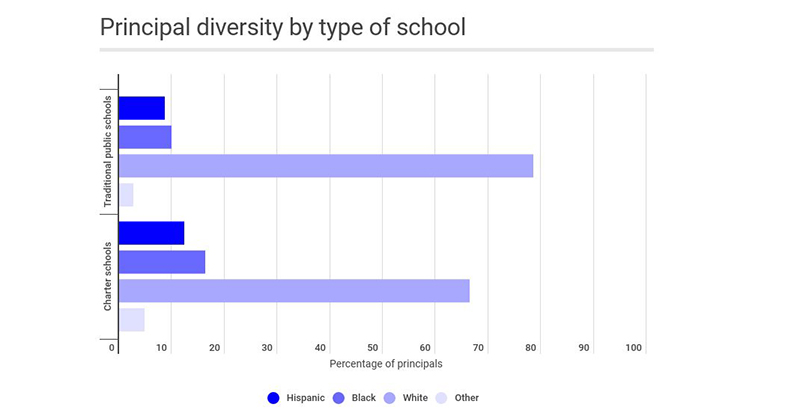Part
01
of one
Part
01
Black and Latinx School Leadership
According to the 2013 NCES condition of education report, about 7% of K-12 administrators are Latinos, 80% White, and 10% African Americans. According to researchers at Vanderbilt University, Black and White principals in the United state tend to employ instructors who are the same race as them.
Changes in the total number of US K-12 Black and Latina school leaders
- In the year 2008, approximately 11% of K-12 principals were blacks and 6% were Latinos.
- According to the 2013 NCES condition of education report, about 7% of K-12 administrators are Latinos, 80% White, and 10% African Americans.
- According to researchers, in 1972, the population of Black principals dropped from 44 to 31. That is a 30 percent decline in Black principals.
- The rate of new black and Hispanic principals was more than the percentages of skilled black and Hispanic principals in public schools. Black principals constituted 11% "of all new public school principals, compared with 8 percent of all experienced principals in public schools."
- New Latina public school principals represented about 8% of all new principals in 2011–12, compared with nearly 5% of all qualified Hispanic principals in public schools.
- Based on the National center for education survey data, about 8.9% of principals were Hispanic, 10.5% black, and 2.9% different races in 2018.
- The same reports state that approximately 66.5 percent of principals in chartered schools were white, while 12.3% were Hispanic and 16.3%.
- National center for education survey data also reviewed that "at schools where 75 percent or more of students were eligible for free or reduced-price lunches, almost 60 percent of teachers were white while 16.5 percent were Hispanic and 21 percent were black."
- According to K12 dive, the rate of color superintendents is gradually increasing, from 8.6% in 2020 to 6% in 2010 and 5% in 2000.
Benefits of having a Black or Latina leader at a K-12 school
Hiring teachers
- According to researchers at Vanderbilt University, Black and White principals in the United state tend to employ instructors who are the same race as them.
- K-12 schools with black principals are 5 to 7% more likely to hire Black educators.
Retention rate
- Researchers also discovered that "retention rates are higher for teachers who share their principal’s racial identity."
- Researchers found that replacing a school’s principal from a white to a black raised the proportion of "black teachers in a school after five years by 5.3 percentage points in Missouri and 5.2 percentage points in Tennessee."
- Black educators at institutions where the principal was also African American were 2 to 5% less prone to transfer schools.
Turnover
- According to researchers, shared backgrounds, communication styles, and values enable leaders and educators of a similar race to work together more effectively.
- This also enhances a teacher’s responsibility to their school.
- There are approximately 10% of black principals in the United States
Student performance
- The availability of an African American principal as a leader and, a role model in a K-12 school has a positive impression on Black students.
- Researchers also found proof to recommend that having black educators improved performance in math for black students. "And even in the absence of hiring a black teacher, there were positive math gains for black students under a black principal."
- A 2017 study by the IZA Institute of Labor Economics found that "having just one black teacher in elementary school significantly decreases the risk of dropping out by nearly 40 percent."
Latina Student
- According to researchers, Latina "students in Texas had higher standardized test scores in schools with Latina administrators, results that appeared to be driven by the higher shares of Latina teachers in those schools."
- Latina students are more inclined to attend college if they have Latino teachers and principals.
Research strategy
The research team searched through different government databases, News articles, surveys, and more. We aimed to provide changes in the total number of US K-12 Black and Latina school leaders and the benefits of having a Black or Latina leader at a K-12 school. The team found that data was available for 2008,2012 and 2018. Unfortunately, information for other years was unavailable. We have also found data on the benefits of having a black principal. There was no direct information on the trauma students face when they lose their black leaders.
